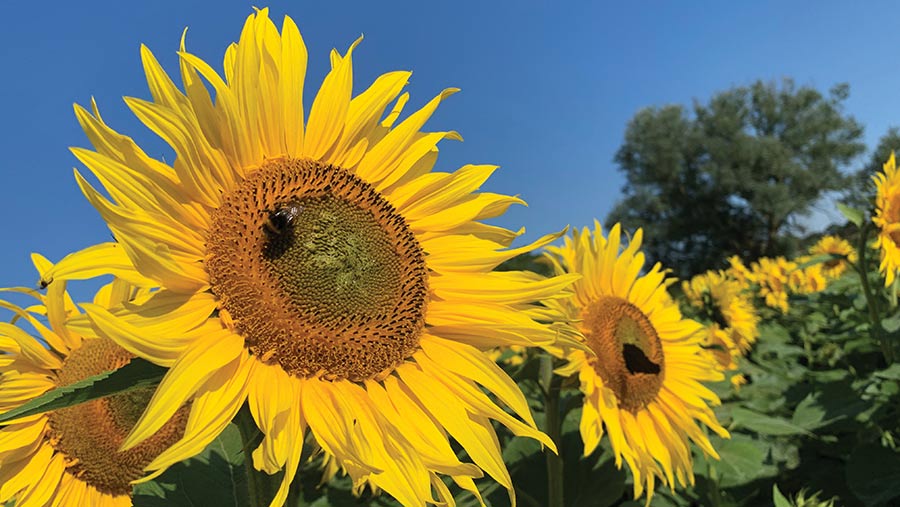Could sunflowers fill the cropping gap this spring?
The first UK marketing pool for sunflowers gives farmers an alternative spring option to make up some of their winter cropping shortfall.
Latest AHDB figures show that the wheat area is down by 15%, OSR is down by 28%, while winter barley is down by 22%. This is due to a combination of the lower levels of planting and crop losses resulting from the severe weather.
Farmers are, therefore, looking to replace some of this with spring crops, but options are being restricted with seed not being available for mainstream options like wheat and barley.
See also: Could carbon-cutting carinata give growers a profitable break?
One option is to give sunflowers a try in 2024, perhaps replacing a failed oilseed rape crop or simply offering a later-drilled spring option.
Farmers will also benefit from the UK’s first sunflower pool, launched earlier this year by United Oilseeds on the back of increasing interest in the crop. Within the pool, farmers are contracted to grow the Grainseed variety Bella.
This growing interest in the oilseed also saw the first trials for some years in the UK, carried out by Edward Stanford, the sunflower specialist at Grainseed.
“Little trial work has been carried out in the UK since the early 2000s until last year. With climate change and increasing temperatures, the geographic area has already expanded for sunflowers in the UK.”
Sunflowers can be successfully produced south of a line from the Wash to the Bristol Channel, but this area has now expanded northwards. “I can see sunflowers really flourishing in the UK within five years,” he says.
Based on his years of experience, Edward answers some key questions for growing the crop.

Edward Stanford © Grainseed
Where can you grow sunflowers?
They can be grown on any soil type and the optimum pH is 6.5 to 7.5. They grow well on potash rich clay and clay loam soils, and in open sunny sites.
When should they be drilled?
Sunflowers should be drilled at a depth of 3-5cm from the 10 April onwards depending on frost and wet conditions, but a consistent 7C soil temperature is the main driver for the drilling window.
It is important to establish the crop well.
“Take time to drill properly. Sunflowers are sown at 110,000 seeds/ha, rising to 120,000 seeds/ha on heavier clay soils to achieve a population of 100,000 plants/ha on a 25-45cm row width.”
Ed says the seed rate is very important as it governs the seed head size, with yield coming from smaller heads.
Where do they fit in rotations?
Sunflowers should not be grown on a closer than one in four years rotation to prevent disease (such as sclerotinia) build up in the soil. Do not follow sunflowers with potatoes.
Seed is treated with a fungicide to protect from damping off and seedling blight. “If your oilseed rape crop fails in the autumn for some reason, sunflowers can be grown in the spring.”
What inputs should farmers expect to use?
Sunflowers are a low input crop, with seed being the most expensive component. Being drilled in April allows weeds such as blackgrass to be controlled by a stale seed-bed with glyphosate.
A pre-emergence herbicide containing pendimethalin (Stomp) is used for early weed control, but later in the season, if weeds germinate, they then die as the crop closes in and prevents sunlight getting through.
Pigeons can be problematic for the first 10 days post-drilling. Slugs at seedling stage can also be a risk. If numbers are high, use slug pellets.
Once the crop has two cotyledons or after 10 days, it rarely needs any further protection against these pests. Fertiliser needs are low and often zero.

© Grainseed
What yields should farmers expect?
Average yields in the UK are between 1 and 2t/ha, with best results usually in hot dry years. A variety such as Bella reaches a height of 150cm tall and it has good standing power.
The flower head should be around 10cm across, and the canopy should close over to shut out sunlight.
How is the crop harvested?
The crop is desiccated when seed is at 15-30% moisture. The stem should be fully dead and no longer green or yellow.
Harvest occurs, using a normal cereal combine with minor adjustments, normally in the first week of October. This means farmers can drill winter wheat as a following crop.
Sunflower seeds dry out fast and can be dried on an air-drying floor down to 15% moisture, before drying with warm air down to 9% moisture.
At harvest, the back of the seed head may be infected with botrytis or sclerotinia, if conditions are mild and wet.
By growing an early variety such as Bella, harvest takes place before these diseases are problematic.
How does the new United Oilseeds buying pool work?
United Oilseeds launched the first buying pool for sunflower seeds in the UK earlier this year with a price of between £350 and £450/t. Growers will be offered “produce of area” contracts and grow Bella.
Requirements include maximum 9% moisture, maximum 2% admix, maximum 4% broken kernals and 10-15mm seed size.
Sunflower variety
Neil Groom, general manager for Grainseed, says Bella is an early maturing, high yielding sunflower variety performing consistently well in trials and commercially in England.
He says it is an early variety with a high oil content of 48-50%. Bella has good standing ability, reducing neck snapping, high dry matter yield and excellent disease resistance, and has been bred for UK conditions.
